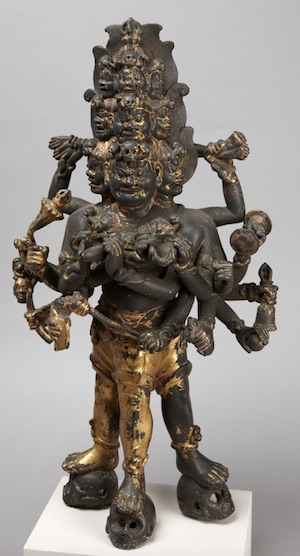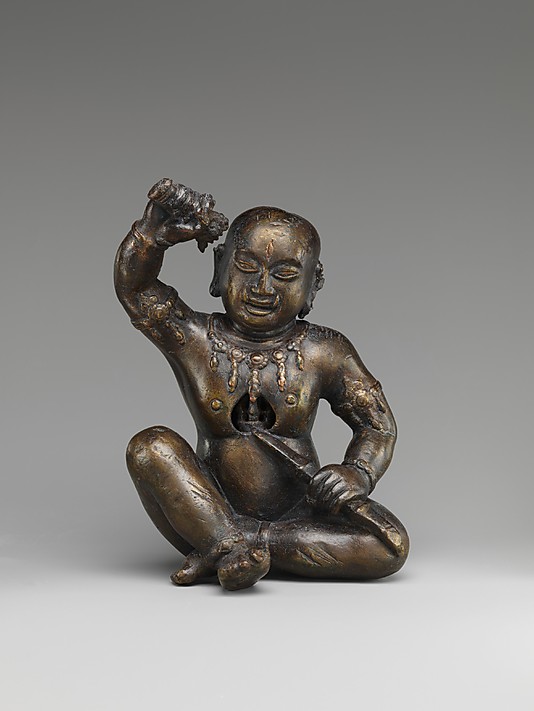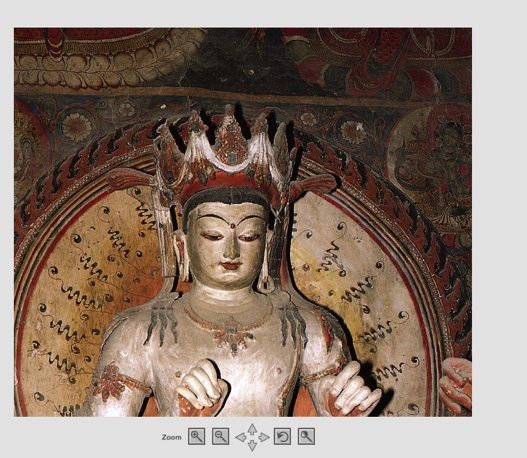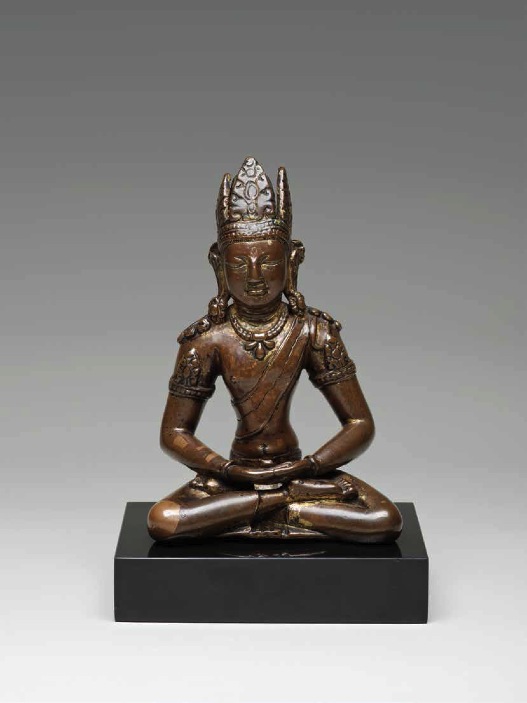
12th-13th century, Dali Kingdom, Mahakala, gilt bronze, 43,5 cm, inventory nº y1969-109 at the Princeton University Art Museum (USA).

Mentioned in an essay by Zhang Yongkang on Bonhams along with a 50 cm gilt bronze Mahakala with nine heads, eighteen arms, and three legs at the Yunnan Provincial Museum, this rare form of the deity appears with wings and flanked by two attendants on a late 12th century silk painting by Zhang Shengwen, now at the National Museum in Taipei. He has two main pairs of hands (which is unusual), in which he holds a conch shell and a skull cup. His upper hands support a body stretched behind his first row of heads, his lower hands clutch a snake, the remaining left hands hold a drum, possibly a trisula on a long stick (missing here but featured on the painting), a vajra bell, a sphere, a toad; the remaining right hands hold a half-vajra on a flower (blue lily?), possibly another trisula, a severed head, what looks like a tusk or a horn, a tortoise. His nine heads, with flaming hair at the back, are topped with a half-vajra finial and adorned with skulls tied with snakes (a three-skull tiara for the main head, one skull for the others). He wears a human hide as an apron and is adorned with a necklace made of skulls, snake bracelets and anklets, and floral armbands. There is a skull under each of his three feet.

Probably 12th century, Dali Kingdom, Lokapala Vaishravana, gilt bronze, 45,5 cm, details and photo on British Museum in London (UK).
The British Museum identifies him as the Guardian King Vaishravana (despite the absence of armour and felt boots or sandals). On this example, and the next two, he has no armbands, his necklace is made of severed heads tied with a snake, all the heads have a one-skull tiara bound with a snake.

(labelled ‘China, 1200-1299, Trailokyavijaya, gilt metal, Dali Kingdom, private collection’ on HAR
The same deity standing on a triangular base that is depicted on the painted silk scroll mentioned above.

12th-14th century, Dali Kingdom, bronze with traces of gilding, 41,9 cm, details from an article by Béla Kelényi on academia.eduand photo on HAR , item nº 70.0/ 7451 at the American Museum of National History in New York (USA). (Nowhere to be found on the AMNH website).
Compared with the previous works, the bell and the severed head are on the opposite side.

Circa 13th century?, China, (Dali Kingdom), Dharmapala, gilt bronze, 9 cm, Christie’s, 1976 lot 165 (London), Fig. 10 in the above-mentioned article by Béla Kelényi.
As to this smaller statue, the author of ‘The Choreography of Identities: a Peculiar Type of Statue from the Dali Kingdom’ mentions a horn and possibly a pestle in two of the right hands, a kila peg, a horn, and a globe in the left ones (difficult to identify on this photograph). We can see some large skulls strung around his neck.

Circa 14th century (or later?), Dali Kingdom, deity, copper with traces of gilding, 30,9 cm, Fig. 1 on Béla Kelényi , photo by Miklós Sulyok, Ferenc Hopp Museum of Asiatic Arts in Budapest (Hungary), inventory nº 4396.
The pointed hair, sharp facial features, and rather sharp contours depart from the style of the previous works, and are reminiscent of 18th century Chinese-style works. He wears a scarf with serpentine ends and has what looks like a trumpet made from a horn in one of his left hands and a tusk (?) on the opposite side.
Both Béla Kelény’s article and the HAR website include metal images of a nine-head and three-leg deity made in nearby Tibet, and/or China and possibly Mongolia during the 18th and 19th century, but they only have eight arms and they stand on a lotus pedestal.




































